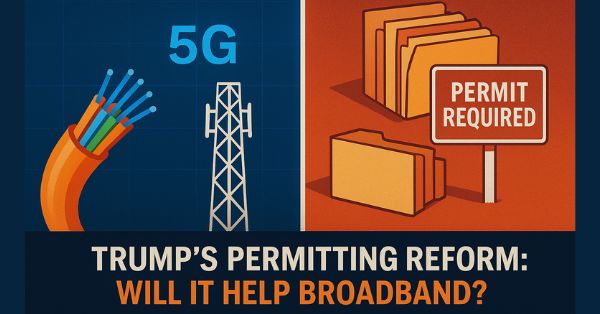President Trump’s latest executive order seeks to modernize and accelerate the environmental permitting process for infrastructure projects in the United States. While the move has drawn attention across sectors, its implications for the telecom industry, particularly broadband deployment—remain uncertain. Despite its broad scope, the order does not explicitly reference telecom or broadband, leaving many in the industry wondering how much of a difference it will actually make.
What Trump’s Permitting Reform Order Means for the U.S.
The executive order outlines several steps to improve the speed, transparency, and coordination of the federal permitting process. It directs agencies to:
- Maximize the use of technology and digital tools
- Accelerate decision-making timelines
- Improve interagency coordination
- Establish a new Permitting Innovation Center to design and test prototype tools for permitting
The order emphasizes reducing delays and cutting down on paper-based application systems. It names roads, bridges, power plants, mines, and factories as the types of infrastructure projects targeted by the reform—telecom is conspicuously absent.
Why Telecom and Broadband Providers Are Anxious About the Order
Though the order doesn’t mention telecom or broadband infrastructure, it arrives at a time when network providers have been vocal about how cumbersome and outdated permitting processes hinder broadband rollouts—especially for 5G and FWA deployments.
According to the Rural Wireless Association (RWA), NEPA (National Environmental Policy Act) reviews have become costly and time-consuming. In filings with the FCC, the group argued that these delays often outweigh the actual environmental impact, especially for small wireless deployments with minimal footprint.
Many telecom builds—such as new towers, fiber routes, or small cell installations—require various environmental permits, even when the impact is low. Streamlining those processes would be beneficial, in theory. But the executive order’s lack of telecom-specific language makes its application unclear.
Gaps in the Order: Broadband Permitting Challenges Still Unsolved
While the executive order outlines a broad vision for permitting modernization, it stops short of addressing the specific, well-documented roadblocks that broadband providers routinely face. The telecom industry has long argued that streamlining infrastructure approvals must include concrete action on the bottlenecks unique to digital network deployments—especially those that directly delay last-mile connectivity and rural access expansion.
1. Pole Access Still a Major Obstacle for Broadband Rollout
The most glaring omission from the executive order is any reference to pole attachments, a long-standing bottleneck in broadband deployment.
“The biggest concern we have heard about network expansion from ISPs concerns access to utility poles,” said Blair Levin, a former FCC official and current policy adviser at New Street Research.
This is a significant issue. Telecom companies often need to attach fiber or small cells to utility poles—many of which are controlled by electric utilities or municipalities. Delays, high rental fees, or disputes over access can derail broadband timelines.
While the FCC has created a rapid response team to resolve pole attachment disputes, 23 states and Washington D.C. manage their own pole attachment rules, creating a patchwork of regulations that complicates deployment efforts.
2. State and Federal Permitting Barriers Remain for Telecom Projects
Another critical gap in the executive order is the lack of attention to federal lands and state or local permitting laws. Many telecom builds traverse public lands, and rules governing those areas can vary significantly. Broadband providers have flagged these as some of the most difficult and time-consuming permits to obtain.
“Federal permitting is only half the battle,” Levin noted. “The EO doesn’t cover the layers of regulation that broadband providers face from states and municipalities.”
This omission significantly limits the EO’s immediate utility for accelerating telecom deployments.
Could Trump’s Permitting Reforms Indirectly Help Broadband?
Despite the lack of specificity, industry analysts believe the order could have indirect, long-term benefits for broadband and telecom:
- Digital permitting platforms: If the new Permitting Innovation Center produces tech solutions, those could trickle down to telecom projects.
- Policy momentum: The EO could set the stage for more telecom-specific reforms by drawing attention to permitting delays across sectors.
- FCC engagement: Policymakers, including FCC Commissioner Brendan Carr, may leverage the EO’s principles to drive industry-focused reforms.
Levin noted that while the executive order “is not targeted at the principal permitting concerns of broadband network providers,” the initiative may help spur innovation in permitting processes that eventually benefit telecom.
Telecom Industry Responds with Cautious Optimism to Permitting Reform
Telecom trade associations welcomed the EO with measured optimism.
“Anything that boosts the efficiency, ease, and speed of the permitting process on federal, state, or Tribal lands—we’re for,” said a spokesperson from the Wireless Internet Service Providers Association (WISPA).
Incompas CEO Chip Pickering went a step further, linking the order to America’s global competitiveness in areas like AI and data infrastructure: “The EO directly addresses America’s urgent need to outpace global competitors in the critical AI race. It supports the buildout of high-speed broadband, energy grids, and data centers—all of which are foundational to deploying next-gen AI systems.”
Telecom Reform Still Lags Despite Permitting Order Momentum
The executive order may improve permitting in a general sense, but it doesn’t resolve some of the most entrenched challenges facing broadband deployment:
- Pole access and rental disputes
- State-by-state variance in permitting laws
- Permitting delays on Tribal and federal lands
- Transparent, fair fee structures for infrastructure sharing
While broadband builds might see some efficiency gains from general improvements in how permits are processed, significant regulatory gaps remain.
In July 2024, the FCC proposed measures to streamline environmental and historic preservation reviews for small cell installations. But with that proposal withdrawn earlier this year by Commissioner Carr, and nothing new introduced since, the telecom sector remains in a holding pattern when it comes to meaningful permitting reform.
Trump’s Permitting Reform: A Start, But Not a Breakthrough for Broadband
President Trump’s executive order signals a push to modernize and digitize federal permitting systems. It could create a foundation for future reforms and innovation in how infrastructure gets approved. However, its lack of telecom specificity, absence of solutions for pole attachments, and failure to address state and local regulatory hurdles means that its real impact on broadband deployment is still limited—for now.
For the telecom industry, the executive order is best viewed as a small step forward rather than a sweeping solution. It offers the potential for improvement but stops short of delivering the targeted reforms that ISPs and wireless providers have long sought.


















